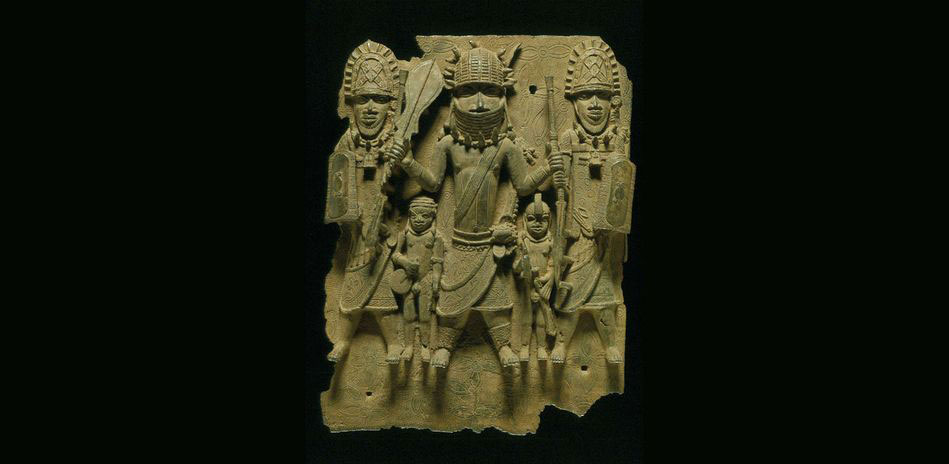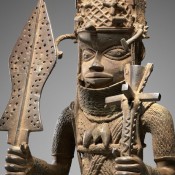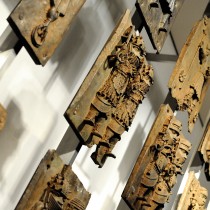The collection of the Staatliche Museen zu Berlin’s Ethnologisches Museum (Ethnological Museum) contains more than five hundred objects from the former Kingdom of Benin, now Nigeria. In 1897 British troops conquered the Kingdom of Benin, looted the royal palace and exiled Oba Ovonramwen, the last independent king, to Calabar. Thousands of objects were shipped to London as war booty and sold there. Hundreds more of the looted objects remained in Nigeria for a time but then also ended up in European and North American museums via networks of European and African businesspeople and dealers.
The Berlin museum, too, benefitted from the colonial system and its “acquisitions” obtained through violence. Since 2010 it has been a member of the Benin Dialogue Group, in which museums in Europe discuss the future of the Benin objects in their collections with Nigerian partners. In March 2021 concrete negotiations on restitutions to Nigeria began at the government level. These negotiations have now having been finalised through the signing of a Joint Declaration. A few days ago, the Stiftungsrat der Stiftung Preußischer Kulturbesitz (Board of the Prussian Cultural Heritage Foundation), chaired by Minister of Culture Claudia Roth, decided that an agreement regarding the transfer of ownership of the objects from the Ethnologisches Museum and loans should be concluded with the responsible authorities in Nigeria in the latter half of 2022.
First Restitution on 1 July 2022
As a prelude to the restitution process now beginning and on behalf of the other German museums involved in the process, two objects from the Ethnologisches Museum’s collection were handed over to Nigeria as part of an initial agreement on 1 July 2022: a commemorative head of a king and a relief plaque depicting a king (oba) with four attendants. A further agreement on the other Benin Bronzes held by the Ethnologisches Museum will follow over the course of the year in accordance with the Foundation Board’s decision.
Commemorative Head of a King
The durable materials of brass and ivory were reserved for the oba (king). Altar ensembles with commemorative heads of deceased kings and ivory tusks (olifants) carved with figures and emblematic representations were central to the annual cycle dedicated to the royal ancestral cult and the renewal of the kingship.
Provenance
-Commissioned by the Igun Eronmwon (guild of brass founders) in the Kingdom of Benin for a royal commemorative altar
-Inherited by Oba Ovonramwen (c. 1857–1914, r. 1888–97), royal palace, Benin City
-Looted in connection with the British conquest of Benin, 1897
-In unknown possession after the conquest of the Kingdom of Benin
-Came into the possession of Consul Eduard Schmidt, an employee of the Woermann Line, between 1897 and 1898 in the area that would become colonial Nigeria
-Sold to the Königliche Museum für Volkerkunde (today the Ethnologisches Museum), 1898
Relief Plaque of a King (Oba) with Four Attendants
This relief plaque shows a king with four attendants. Such plaques, produced using the lost-wax technique, were located on the wooden pillars of the palace’s long, rectangular interior courtyards in the historical Kingdom of Benin (c. AD 900 – late 19th century). They show repeating representations of the king, dignitaries, the Portuguese, elements of the cosmos, and animals.
Provenance
-16th century, commissioned by Oba Esigie (r. 1517–50) or his son, Oba Orhogbua (r. 1550–70), royal palace, Benin City
-Inherited by Oba Ovonramwen (c. 1857–1914, r. 1888–97), royal palace, Benin City
-Looted in connection with the British conquest of Benin, 1897
-Possession unknown after the conquest of the Kingdom of Benin
-Came into the possession of Consul Eduard Schmidt, an employee of the Woermann Line, between 1897 and 1898 in the area that would become colonial Nigeria
-Sold to the Königliche Museum für Volkerkunde, 1898





